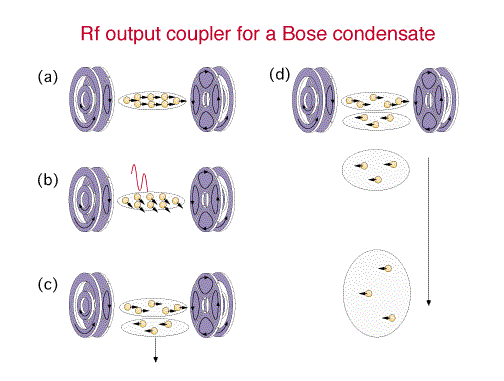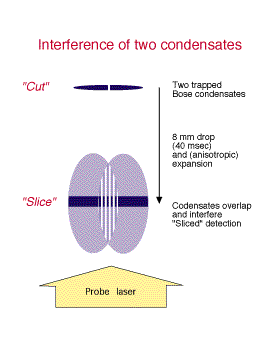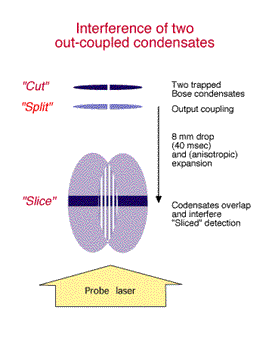The Atom Laser
A brief commentary by Wolfgang Ketterle
Dept. of Physics and Research Laboratory of Electronics, MIT
Recent work at MIT has realized an atom laser. In this note, the concept
and properties of an atom laser are discussed, and also the techniques
which were necessary to demonstrate the atom laser.
What is an atom laser?
An atom laser is analogous to an optical laser, but it emits matter waves
instead of electromagnetic waves. Its output is a coherent matter wave,
a beam of atoms which can be focused to a pinpoint or can be collimated
to travel large distances without spreading. The beam is coherent, which
means, for instance, that atom laser beams can interfere with each other.
Compared to an ordinary beam of atoms, the beam of an atom laser is extremely
bright. One can describe laser-like atoms as atoms "marching in lockstep".
Although there is no rigorous definition for the atom laser (or, for that
matter, an optical laser), all people agree that brightness and coherence
are the essential features.
The parts of an atom laser
A laser requires a cavity (resonator), an active medium, and an output
coupler. In the MIT atom laser, the "resonator" is a magnetic trap in which
the atoms are confined by "magnetic mirrors". The active medium is a thermal
cloud of ultracold atoms, and the output coupler is an rf pulse which controls
the "reflectivity" of the magnetic mirrors.
The gain process in an atom laser
The analogy to spontaneous emission in the optical laser is elastic scattering
of atoms (collisions similar to those between billiard balls). In a laser,
stimulated emission of photons causes the radiation field to build up in
a single mode. In an atom laser, the presence of a Bose-Einstein condensate
(atoms that occupy a "single mode" of the system, the lowest energy state)
causes stimulated scattering by atoms into that mode. More precisely, the
presence of a condensate with N atoms enhances the probability that an
atom will be scattered into the condensate by N+1.
In a normal gas, atoms scatter among the many modes of the system. But
when the critical temperature for Bose-Einstein condensation is reached,
they scatter predominantly into the lowest energy state of the system,
a single one of the myriad of possible quantum states. This abrupt process
is closely analogous to the threshold for operating a laser, when the laser
suddenly switches on as the supply of radiating atoms is increased.
In an atom laser, the "excitation" of the "active medium" is done by
evaporative cooling - the evaporation process creates a cloud which is
not in thermal equilibrium and relaxes towards colder temperatures. This
results in growth of the condensate. After equilibration, the net "gain"
of the atom laser is zero, i.e., the condensate fraction remains constant
until further cooling is applied.
Unlike optical lasers, which sometimes radiate in several modes (i.e.
at several nearby frequencies) the matter wave laser always operates in
a single mode. The formation of the Bose condensate actually involves "mode
competition": the first excited state cannot be macroscopically populated
because the ground state "eats up all the pie".
The output of an atom laser
The output of an optical laser is a collimated beam of light. For an atom
laser, it is a beam of atoms. Either laser can be continuous or pulsed
- but so far, the atom laser has only been realized in the pulsed mode.
Both light and atoms propagate according to a wave equation. Light is governed
by Maxwell's equations, and matter is described by the Schroedinger equation.
The diffraction limit in optics corresponds to the Heisenberg uncertainty
limit for atoms. In an ideal case, the atom laser emits a Heisenberg uncertainty
limited beam.
Differences between an atom laser and an optical laser
-
Photons can be created, but not atoms. The number of atoms in an atom laser
is not amplified. What is amplified is the number of atoms in the ground
state, while the number of atoms in other states decreases.
-
Atoms interact with each other - that creates additional spreading of the
output beam. Unlike light, a matter wave cannot travel far through air.
-
Atoms are massive particles. They are therefore accelerated by gravity.
A matter wave beam will fall like a beam of ordinary atoms.
-
A Bose condensates occupies the lowest mode (ground state) of the system,
whereas lasers usually operate on very high modes of the laser resonator.
-
A Bose condensed system is in thermal equilibrium and characterized by
extremely low temperature. In contrast, the optical laser operates in a
non-equilibrium situation which can be characterized by a negative temperature
(which means "hotter" than infinite temperature!). There is never any population
inversion in evaporative cooling or Bose condensation.
Historical roots
The atom laser is based on the quantum-mechanical wave nature of particles.
Louis Victor de Broglie, during his Ph.D. thesis in 1923, predicted that
all particles have wave properties and gave a famous formula stating that
the wavelength of a particle varies inversely with its speed. (The wavelength
equals Planck's constant divided by the mass and the speed of the particle.)
In 1917, Albert Einstein discovered theoretically the stimulated emission
of light which is the basic mechanism generating laser light. In what was
then unrelated work, in 1924, he and Satyendra Nath Bose predicted a novel
form of matter which forms at very low temperatures which is now called
a Bose-Einstein condensate.
Potential applications of an atom laser
Although an atom laser has now been demonstrated, major improvements are
necessary before it can be used for applications, especially in terms of
increased output "power" and reduced overall complexity. Laser-like atoms
exist only in an ultrahigh vacuum environment, and so it is unlikely that
the atom laser will ever improve supermarket scanners or CD players! However,
there are many applications in fundamental research and industry where
atomic beams are used, e.g., atomic clocks, atom optics, precision measurements
of fundamental constants, tests of fundamental symmetries, atomic beam
deposition for chip production (atom lithography), and, more generally,
nanotechnology. The atom laser may have an impact on all of these applications.
Today, if you have a demanding job for light, you use a laser. In the future,
if there is a demanding job for an atomic beam, you may be able to use
an atom laser.
The steps from a Bose condensate to an atom laser
An important intermediate step towards the atom laser was the realization
of Bose-Einstein condensation (BEC), which was achieved in 1995 by a group
at Boulder and Ketterle's group at MIT. (In 1996, two more groups, a group
at Rice and a second group at Boulder, observed BEC). The Bose condensate
has frequently been compared to photons in a laser beam, but what was missing
was a controlled way of extracting a beam of atoms and a method for determining
whether the Bose condensed atoms are coherent as the photons in a laser
beam. Both these steps have now been taken by the MIT team, thus realizing
the atom laser.
Realization of an output coupler for a Bose condensate
(Phys. Rev. Lett., January 27, 1997) An output coupler is one of the essential
elements of a laser. It allows the controlled extraction of atoms from
the Bose condensate, i.e. the generation of a (quasi-) continuous beam
or multiple pulses. Before the MIT group realized an output coupler, the
entire condensate was either trapped or freely expanding.
The MIT group achieved the controlled extraction of atoms in the following
way: Magnetically trapped atoms can be regarded as atoms bouncing back
and forth between magnetic mirrors. The magnetic mirror is 100% reflective
for atoms with their magnetic moment anti-parallel to the magnetic field,
and fully transmissive for the opposite orientation. The MIT group tilted
the magnetic moment of the atoms by a variable angle, thus adjusting the
reflectivity of the magnetic mirror. This was done by using short pulses
of an oscillating magnetic field.
When the MIT group realized the output coupler in July 1996, they had
all the elements for an atom laser together. However, a crucial feature
of a laser had yet to be demonstrated: the coherence of the condensed atoms.
This was achieved in November 1996 through the observation of high-contrast
interference between two Bose condensates.
Demonstration of coherence of a Bose condensate
(Science, January 31, 1997) It should be noted that laser light has two
important features: Brightness and coherence. Brightness does not necessarily
mean high absolute power, but the concentration of power into the direction
of propagation and in a small frequency interval (monochromatic light).
This is the reason why a laser pointer is brighter than the sun! The second
important feature is coherence, i.e., all the photons in a laser form one
macroscopic wave (they "oscillate synchronously").
In the case of atoms, a Bose condensate is very cold and coherent. Coldness
corresponds to brightness in the optical case, because a very low temperature
restricts the quantum states which are accessible to the atoms to the lowest
states of the system (Brightness in the optical case also means restricting
the photons to a few modes of the laser resonator). It is the low energy
of the condensate which was studied in previous experiments and used to
identify the Bose condensate. However, although coldness and coherence
are related, there has been some controversy about how coherent the atomic
Bose condensate would be. It has been argued that the atoms first become
very cold, but then it would take much longer (maybe forever) for the coherence
to build up. Furthermore, collisions among the atoms and with background
gas were predicted to destroy the coherence. The MIT results resolve these
issues. They prove that a Bose condensate is coherent, and that a coherent
beam of atoms can be extracted from it.
The proof of the coherence was obtained by observing a high contrast
interference pattern when two Bose condensates overlapped. The MIT researchers
could directly photograph this pattern which had a period of 15 micrometer,
a gigantic length for matter waves. (Room temperature atoms have a matter
wavelength of 0.04 nm, 400,000 times smaller). The interfering condensates
were propagating with an energy of 0.5 nanokelvin - the coldest temperature
ever reported. However, temperature has lost its meaning in this regime,
it is only used as a measure for the residual (non-thermal) energy of the
atoms.
When matter waves interfere destructively, it is as if one atom plus
one atom give zero atoms! Of course, the matter is not destroyed, and the
atoms appear elsewhere. Nevertheless, the interference of streams of atoms
from separate sources is a dramatic phenomenon.
Other techniques used to realize the atom laser
A variety of schemes to realize an atom laser have been discussed during
the last several years. The MIT group chose a particularly simple way.
They cooled an atomic gas to extremely low temperatures until it spontaneously
formed a Bose-Einstein condensate with "laser-like" properties, and then
extracted these atoms into output pulses (see above).
The MIT work was based on powerful cooling techniques which were used
to reduce the temperature of a sodium gas by a factor of a billion, from
the temperature of an oven to around one microkelvin. These cooling techniques
are laser cooling (the key techniques were invented at NIST (W. Phillips),
Bell Labs/Stanford (S. Chu), MIT (D. Pritchard)) and evaporative cooling
(developed at MIT (T. Greytak, D. Kleppner)). Many other groups in the
atomic physics and condensed matter communities have contributed to these
efforts (e.g., Amsterdam, Boulder, Cornell, Harvard, Paris). Between 1992
and 1995, Ketterle's group pioneered ways to combine laser cooling and
evaporative cooling. The combined cooling was key to the observation of
Bose-Einstein condensation in Boulder in June and at MIT in September of
1995.
In laser cooling, the atoms are bombarded with laser light. The frequencies
and polarizations of the laser beams are chosen in such a way that the
photons emitted by the atoms are slightly more energetic than the absorbed
photons. The energy difference is responsible for the cooling effect. After
absorbing and emitting about 100,000 photons, the atoms reach a temperature
of about 100 microkelvin. Subsequently, the atoms are cooled to BEC using
evaporative cooling. In this technique, the hottest atoms are removed from
the atomic sample, thus reducing the average energy (and therefore the
temperature) of the remaining atoms. The same principle cools a cup of
coffee and water in a bathtub.
The atoms have not only to be cooled, but also very well insulated from
the room-temperature environment. This is accomplished by purely magnetic
confinement inside an ultrahigh vacuum chamber.
The MIT team
Ketterle's team includes potdocs Christopher Townsend and Hans-Joachim
Miesner, and graduate students Michael Andrews, Marc-Oliver Mewes, Dallin
Durfee, and Dan Kurn. Over the years, 4 postdocs, 8 graduate students and
7 undergraduate students have contributed to the experiment. The experiment
started as a collaboration with Prof. David E. Pritchard (until 1993).
Funding was provided by ONR, NSF, JSEP, and the Packard foundation.
Figures

Figure 1: The rf output coupler. Figure (a) shows a Bose condensate
trapped in a magnetic trap. All the atoms have their (electron) spin up,
i.e. parallel to the magnetic field. (b) A short pulse of rf radiation
tilts the spins of the atoms. (c) Quantum-mechanically, a tilted spin is
a superposition of spin up and down. Since the spin-down component experiences
a repulsive magnetic force, the cloud is split into a trapped cloud and
an out-coupled cloud. (d) Several output pulses can be extracted, which
spread out and are accelerated by gravity.

Figure 2: Setup for observing the coherence of a Bose condensate. This
is done by creating two independent Bose condensates in a special trap
which uses magnetic and optical forces and has two separated "pockets".
The two condensates are separated by a laser beam which "cuts" the cloud
into two pieces. When the trap is switched off, the condensates fall down,
spread out and eventually overlap. In the overlap region, a high-contrast
interference pattern was observed, a clear proof for the coherence of the
Bose condensates. A "sliced" observation was chosen to avoid blurring of
the interference pattern by integrating along the direction of propagation
of the probe laser beam.

Figure 3: The interference experiment of Fig. 2 was also done with two
condensates coupled out from a trap holding two independent condensates.
The observation of an interference pattern proved that the rf output coupler
preserved the coherence.



